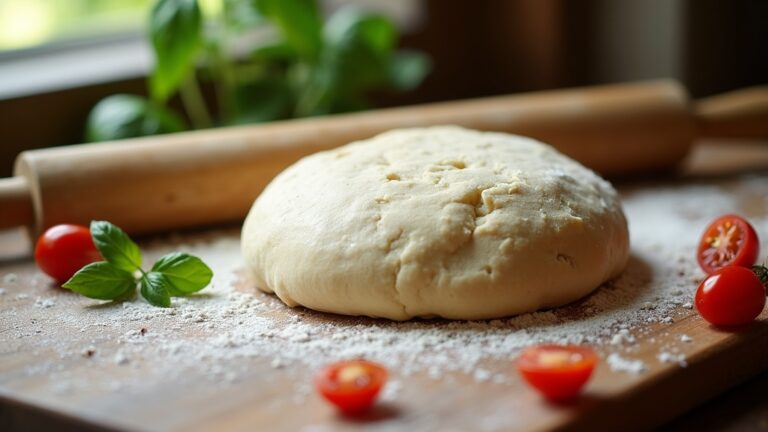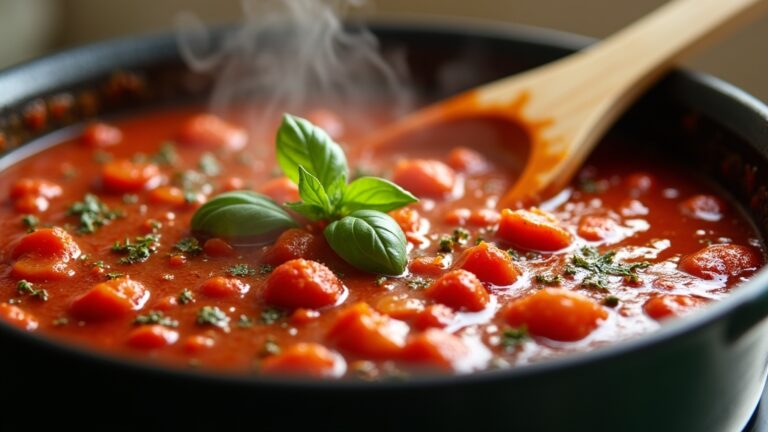Aoli Recipe Aioli Sauce
I adore aioli sauce for its rich, garlicky flavor that elevates any dish! It’s easy to whip up at home with just garlic, egg yolk, olive oil, lemon juice, and seasoning. Start by mashing the garlic into a paste and mixing in the egg yolk. Gradually whisk in the olive oil until smooth. Finish with a splash of lemon juice for a zesty kick. If you’re curious about ways to customize this classic, there’s so much more to explore!
Contents
History
When I explore the history of aioli, I can’t help but appreciate its origins in the Mediterranean, where it’s been a staple since ancient times. This creamy garlic sauce has evolved through the centuries, embodying the region’s vibrant culinary culture. Initially, it was a simple blend of garlic, olive oil, and salt, reflecting the natural ingredients available. Over time, as trade routes expanded, new flavors and techniques influenced its preparation, leading to exciting variations. I find it fascinating how aioli represents the Mediterranean’s spirit of innovation, adapting to local tastes while maintaining its essence. Today, it’s a beloved condiment worldwide, reminding us of its rich history and the remarkable journey of culinary evolution that brought it to our tables.
Recipe
Aoli is a traditional Mediterranean sauce that has become a beloved condiment around the world. Known for its rich, garlicky flavor and creamy texture, aoli can enhance a wide variety of dishes from grilled meats to roasted vegetables. Making aoli at home is not only simple but also allows you to customize the flavor to your liking. The classic version is made with just a few basic ingredients, but you can easily add herbs or spices to create your own unique twist.
To get the best results, it’s important to use fresh, high-quality ingredients. The key to a successful aoli is the emulsion process, which combines the oil and garlic into a smooth, creamy sauce. While traditional recipes often call for a mortar and pestle, you can easily make aoli using a food processor or blender for convenience. Once you’ve mastered the basic recipe, feel free to experiment with different flavors and textures to suit your palate.
Ingredients:
- 2 large garlic cloves
- 1 egg yolk
- 1 cup extra virgin olive oil
- 1 tablespoon lemon juice
- Salt, to taste
- Pepper, to taste
To prepare the aoli, start by peeling and mincing the garlic cloves. In a food processor, combine the minced garlic and egg yolk, and blend until smooth. Gradually drizzle in the olive oil while the processor is running to create an emulsion. Once the mixture starts to thicken, add the lemon juice, and season with salt and pepper to taste. Continue blending until you achieve a creamy consistency, adjusting the seasoning as necessary.
When making aoli, it’s important to use room temperature ingredients for better emulsification. If your aoli is too thick, you can whisk in a little water or additional lemon juice to achieve your desired consistency. Additionally, feel free to add flavor variations by incorporating fresh herbs like basil or cilantro, or even spices like smoked paprika for a different twist. Remember to store any leftover aoli in an airtight container in the refrigerator for up to a week. Enjoy your homemade aoli as a dip, spread, or sauce!
Cooking Steps
Let’s get started on making that delicious aoli! First, I’ll prepare the garlic cloves to infuse a rich flavor, then I’ll add the egg yolk for creaminess. As I incorporate the olive oil slowly, I’ll whisk until I achieve that perfect smooth consistency.
Step 1. Prepare Garlic Cloves First
To kick off the process of making a delicious aioli, I start by preparing the garlic cloves. I choose fresh, firm bulbs—after all, they’re the star of this sauce! I peel away the papery skin and then chop a few cloves roughly. The aroma is intoxicating, and I can already feel the garlic benefits kicking in; it’s packed with antioxidants and adds a punch of flavor. Next, I sprinkle a pinch of sea salt over the chopped garlic, which helps to break it down as I use the side of my knife to mash it into a paste. This garlic preparation not only enhances the taste but also guarantees a smooth, creamy texture in my aioli.
Step 2. Add Egg Yolk Next
Next, I reach for one large egg yolk, which is essential for creating that rich, creamy base in my aioli. The benefits of using egg yolk are incredible; it not only adds a luscious texture but also acts as an emulsifier, ensuring that my ingredients meld beautifully. As I drop the yolk into my mixing bowl, I think about the endless aioli variations I can create—think spicy sriracha or zesty lemon. This yolk sets the stage for those bold flavors to shine. It’s fascinating how such a simple ingredient can elevate my sauce from basic to extraordinary. With the egg yolk in place, I can’t wait to incorporate the olive oil next for that velvety finish!
Step 3. Incorporate Olive Oil Gradually
As I prepare to incorporate the olive oil, I know that adding it gradually is key to achieving that perfect emulsion. This step isn’t just about pouring; it’s an art! By using proper emulsification techniques, I can guarantee my aioli turns out creamy and rich.
I start with just a few drops, whisking vigorously to blend, and then I slowly increase the flow. Here are a few tips I keep in mind:
- Choose quality oil types: A good extra virgin olive oil elevates the flavor.
- Maintain a steady hand: This allows for better control of the emulsion.
- Watch for texture changes: As it thickens, I know I’m on the right track!
This gradual process makes all the difference!
Step 4. Whisk Until Smooth Consistency
Achieving a smooth consistency in my aioli is all about the whisking technique. As I begin, I hold my whisk firmly, blending the garlic and egg yolk until they’re fully combined. The magic happens as I slowly incorporate the olive oil—this is where those smooth emulsions come to life. I whisk vigorously, ensuring the oil is fully integrated, creating that luxurious texture. I often switch up my techniques, experimenting with both circular motions and back-and-forth strokes, which seem to enhance the mixture’s silkiness. The key is to remain patient; if I rush, the emulsion can break. With each deliberate whisk, I can feel the aioli transforming into a creamy masterpiece, ready to elevate any dish.
Step 5. Season With Lemon Juice
Once I’ve whisked my aioli to that perfect smoothness, I turn my attention to seasoning it with fresh lemon juice. The bright acidity of the juice adds an essential flavor enhancement, elevating my aioli to new heights. I also love to incorporate lemon zest for an extra zing, marrying the creamy texture with citrusy brightness. Here’s how I do it:
- Squeeze in the juice of half a lemon, adjusting to taste.
- Grate a teaspoon of lemon zest, stirring it in for that fragrant burst.
- Season with a pinch of salt to balance the flavors.
With each addition, I taste and tweak, ensuring my aioli bursts with vibrant, invigorating flavor that’s simply irresistible!
Nutritional Guide
When whipping up aioli, it’s essential to contemplate its nutritional profile, especially if you’re mindful of what you consume. This creamy concoction has its share of caloric content but also offers numerous health benefits. Let’s break it down:
| Nutrient | Amount per Serving |
|---|---|
| Calories | 100 |
| Healthy Fats | 10g |
| Protein | 1g |
| Fiber | 0g |
This flavorful sauce can enhance your dishes while providing beneficial monounsaturated fats, which are great for heart health. Plus, the garlic in aioli is known for its antioxidant properties, making it a delightful addition to your meals. Enjoying it in moderation allows you to savor its richness without guilt!
Final Thoughts
After exploring the nutritional benefits of aioli, I can’t help but appreciate how this simple sauce can elevate a meal while offering some health perks. It’s versatile and invites creativity, making it perfect for innovative cooks like us.
Here are a few serving suggestions to contemplate:
- Spread it on sandwiches for a creamy, flavorful twist.
- Use it as a dip for roasted veggies or crispy fries, adding a gourmet touch.
- Mix in herbs or spices for future variations that keep your tastebuds excited.
This sauce not only complements a variety of dishes but also inspires culinary experimentation. So, don’t shy away from exploring new flavors; aioli’s potential is only limited by your imagination!
Frequently Asked Questions
Can I Make Aioli Without Raw Eggs?
I’ve made delicious vegan aioli using egg substitutes like silken tofu or aquafaba. They blend perfectly, creating a creamy texture without raw eggs, allowing me to enjoy a guilt-free, flavorful dip anytime!
How Long Can Homemade Aioli Be Stored?
You’d think homemade aioli lasts forever, right? In reality, it’s best stored in the fridge for about a week. For ideal freshness, I follow simple storage tips, keeping it tightly sealed and cold. Enjoy!
What Are Common Variations of Aioli?
When I think about common variations of aioli, I’m excited by traditional aioli’s bold garlic flavor, but I love experimenting with flavored variations like roasted red pepper, lemon dill, or spicy sriracha for something unique!
Is Aioli Gluten-Free?
Absolutely, I love that aioli’s ingredients are naturally gluten-free! When I’m looking for a tasty dip, I always opt for gluten-free alternatives, ensuring my culinary adventures remain delightful and inclusive for everyone.
Can Aioli Be Frozen for Later Use?
I’ve found that freezing aioli can work well! Using proper freezing techniques and airtight storage containers, I preserve its flavor. Just remember, texture might change a bit, but it’s still delicious when thawed!
Conclusion
So there you have it—making aioli is as easy as pie, or should I say, as easy as crushing garlic and whisking oil? Who knew gourmet magic could happen in my kitchen? With just a few ingredients, I’ve transformed into a culinary wizard, impressing friends while secretly reveling in my newfound “chef” status. So, let’s raise a toast to the glorious, creamy concoction that’s convinced us all we’re healthier just because it sounds fancy! Enjoy!







